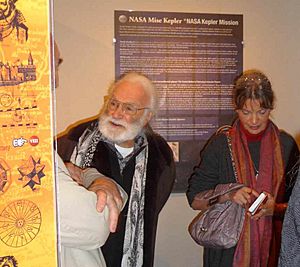Karl H. Pribram facts for kids
Quick facts for kids
Karl H. Pribram
|
|
|---|---|

Karl Pribram in Kepler Museum, Prague, 2010.
|
|
| Born | February 25, 1919 Vienna, Austria
|
| Died | January 19, 2015 (aged 95) |
| Alma mater | University of Chicago (B.S., 1938; M.D., 1941) |
| Known for | Holonomic brain theory |
| Spouse(s) | Katherine Neville |
| Scientific career | |
| Fields | Neuropsychology |
| Influences | Sir Charles Sherrington, Karl Lashley, Dennis Gabor |
Karl H. Pribram was a very important scientist who studied the brain. He was born on February 25, 1919, in Vienna, Austria. He passed away on January 19, 2015, in Virginia, USA, at 95 years old.
Pribram was a professor at several universities, including Georgetown University and Stanford University. He was a neurosurgeon, which means he was a doctor who performed brain surgery. He did amazing work to understand how the brain works.
He helped define the limbic system, which controls emotions and memory. He also studied how different parts of the brain, like the front part and the top-back part, work together.
To many people, Karl Pribram is best known for his idea called the holonomic brain model. This model helps explain how our brains process information, remember things, and even how we become aware of the world around us. He was married to the author Katherine Neville.
How the Brain Works: The Holonomic Model
Karl Pribram's holonomic model suggests a cool way our brain processes information. Think of a hologram. A hologram is a special kind of picture where the whole image is stored in every part of it. If you cut a hologram into pieces, each piece still contains the whole picture, just a bit blurrier.
Pribram thought our brains might work in a similar way. He believed that besides the main connections in the brain, tiny branches of brain cells (called dendrites) also form webs. These webs and the electrical fields around them help process information. This means that information in the brain might not be stored in just one spot. Instead, it could be spread out, like in a hologram.
This idea was inspired by Dennis Gabor, who invented the hologram. Pribram also worked with David Bohm, a physicist. Bohm suggested that if we could see the universe without our eyes' lenses, it might look like a giant hologram. Pribram extended this idea to the brain, saying that our senses might also process information in a holographic way. This helps explain how our brains can handle so much information and memories.
Other Discoveries and Contributions
In the 1940s and 1950s, Karl Pribram made important discoveries about the brain. He showed what the limbic system is made of. This system is very important for our emotions and how we learn. He also studied the prefrontal cortex, which is the front part of your brain. This part helps us make decisions and plan things.
Pribram also found out how our brains choose what sensory information to pay attention to. For example, when you are in a noisy room, your brain helps you focus on a friend's voice and ignore other sounds. He showed that certain brain areas help us organize these choices.
He wrote a book called The Form Within in 2013. In this book, he shared stories about his life and his work. He even told a funny story about how he lost part of his finger. This happened when a chimpanzee named Washoe accidentally slammed his hand.
In 1999, Karl Pribram received a special award called the Dagmar and Václav Havel Award. This award recognized his work in connecting science with other fields like the arts and humanities.
See also
 In Spanish: Karl H. Pribram para niños
In Spanish: Karl H. Pribram para niños

